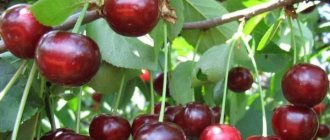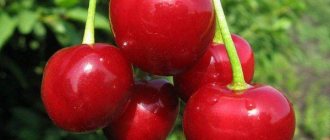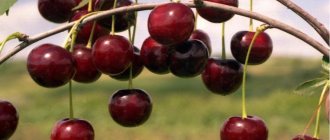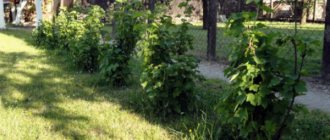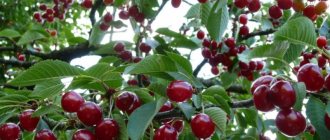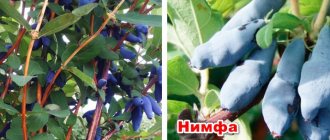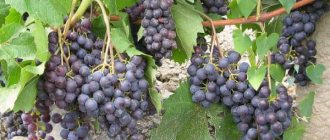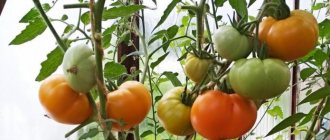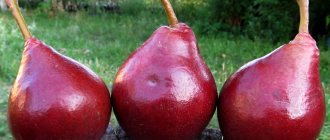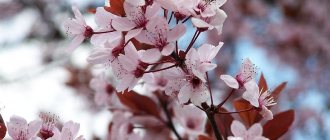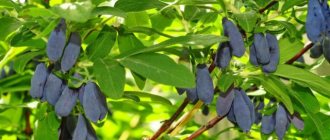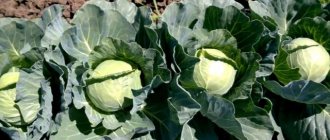Cherry Ashinskaya - what kind of hybrid variety is it?
Ashinskaya cherry is a hybrid that is grown by many gardeners. It is a high-yielding variety that is highly frost-resistant, which means it is suitable for cultivation in many domestic regions.
Main characteristics of culture, advantages and disadvantages
According to the description, this crop is a slender, symmetrical tree that reaches a height of 3 m. The distance from the root collar to the shoots is 30-40 cm.
Cherries are characterized by rapid development. The crown is quite dense. It has a pyramidal shape and is covered with smooth and round leaves of dark green color. They reach 8 cm in length. The shoots are brown with a grayish tint. The branches grow up to 45 cm.
The fruits are large and weigh up to 5 grams. They are characterized by a flattened shape and a dark red hue. Inside there is juicy burgundy pulp, which has a fairly soft consistency. The top of the berries are covered with a rather dense peel.
Important! A characteristic feature of the fruit is considered to be free separation from the stalk. After which a dry mark remains on the berries.
The fruits are large in size and have excellent taste.
Cherries of this variety are characterized by excellent taste. The fruits received maximum points on the tasting scale, since their taste contains sweetness and slight sourness.
The main advantages of the plant include the following:
- resistance to disease development and pest attacks;
- excellent taste;
- long fruiting period;
- high yield parameters;
- large berries;
- the possibility of propagating the culture in different ways;
- drought resistance.
At the same time, culture also has a number of disadvantages:
- not very good transportability;
- late period of ripening;
- fruit ripening at the same time.
Domestic summer residents believe that the pros significantly outweigh the cons. Therefore, Ashinskaya is increasingly appearing in garden plots.
Rules for further care
Despite its unpretentiousness, Lyubskaya cherry, like this variety, also bears fruit better under good growing conditions. To provide the tree with comfort and everything it needs, you should familiarize yourself with the important requirements for fruiting and development of this persistent crop.
Important activities during cultivation:
- The main feature of “wild” varieties is active basal shoot formation. Moreover, if for a garden plant this is an unnecessary loss of strength, then for such a hybrid it is a natural way of reproduction and development. That is why plantings should not be trimmed too much so that a sufficient number of sprouts remain.
- You will still have to thin out the plantings; this is usually done to ensure comfortable harvesting. The formation and permissible number of branches should be chosen at your own discretion.
- For better fruiting, it is necessary to consider placement near plants with the same flowering periods. “Ashinskaya” begins to bloom around the end of May, so the best pollinators for it will be the varieties “Zagrebinskaya” and “Alatyrskaya”.
- Regular feeding is used as needed as a preventive measure. If poor development and growth of the tree is noted, organic and mineral complexes are used.
- The variety tolerates drought well, but still needs watering. With optimal conditions, it will bear fruit better. The berries of this species are not prone to cracking.
- Winter shelter is not needed, because the variety is extremely frost-resistant. Even if freezing of the branches does occur, the plant will quickly recover next year.
- Fruiting is mostly observed on the annual growth (more than 70% of the total harvest), so pruning and thinning is preferable to be done after picking the berries.
But how to care for the Zhukovskaya cherry variety and what description of this variety exists is indicated here.
On the video - how to care for cherries:
The Ashinsky variety is a unique hybrid of wild steppe cherry and its garden analogue. It is characterized by amazing durability and does not require special growing conditions. In addition, it produces fairly large fruits that are pleasant to the taste. In the wild, this miracle is gradually disappearing, so be sure to take the opportunity to plant this unpretentious and surprisingly resilient tree on your site.
It is also worth learning more about what the Turgenevka cherry looks like and what are the features of its cultivation.
History of selection and region of breeding
This crop is considered a relatively young variety. The plant entered the international register only in 2002. The culture was bred at the South Ural Research Institute. There, 4 scientists were involved in its selection.
This variety is a hybrid of garden and bush cherries. At the same time, breeders managed to achieve the almost impossible. This cherry can be propagated by any means, and its varietal characteristics will be preserved.
The crop can be grown in different regions - in Siberia, the Urals, and the Volga region.
Description of the variety
Thanks to its wild relative, the Ashinsky hybrid inherited frost resistance and hardiness, which allows the variety to be grown in any part of the country.
- the plant is slender, fast growing;
- shoot length 30-45 centimeters;
- maximum height 2.5 meters;
- bears fruit for 30 years;
- shoots are oval, without fluff;
- in inflorescences there are 5 flowers;
- lentils are medium in size;
- the bud is smooth, long, slightly curved;
- the flowers grow small and white;
- the peduncle is 25 millimeters long;
- flowers do not tolerate frost and die at -2 °C.
Pyramid cherry has a dense crown with dark, green leaves.
Cherry variety ripening period, yield indicators
Fruiting begins only 4-5 years after planting. At the same time, the cherry tree has a long lifespan. It reaches 30-35 years.
Note! Before the fruiting period begins, the crop blooms, but its ovaries fall off. This is considered quite normal.
A distinctive feature of the crop is the simultaneous ripening of fruits. This allows you to collect all the berries in one go. Ashinskaya cherry belongs to the late varieties. Therefore, the harvest can only be harvested at the end of July. Full ripening occurs in early August.
Characteristics of the tree and fruits
The plant belongs to a productive and winter-hardy variety that ripens late. Average life expectancy is 35 years. Used for private gardening and on an industrial scale.
Drought and frost resistance
- tolerates drought well;
- withstands frosts down to -42 °C;
- flowers do not tolerate frost well.
When damaged by frost, the plant quickly recovers without losing productivity.
Pollination, flowering period and ripening time
The variety is partially self-fertile. The harvest ripens almost simultaneously in the first ten days of August. If there are no pollinators nearby, on average only 35% of the ovaries are fertilized. To increase productivity, it is recommended to plant any stone fruit crop with the same flowering period nearby. Flowers appear at the end of May. Flowering is extended.
Productivity, fruiting
From the fourth year, the plant begins to bear fruit regularly, and this continues until at least 30 years of age. The fruits ripen together. An adult tree produces about 10 kilograms of juicy berries.
Resistance to diseases and pests
The variety has increased resistance to coccomycosis. Not attacked by pests.
Pollinator Species, Best Neighbors
This variety is considered self-fertile. This means that it does not need pollinators. Even the only tree on the site will produce a stable harvest. At the same time, the Ashinskaya cherry itself can serve as a pollinator for other varieties. These include Rubinovaya, Nochka.
When choosing neighbors for this variety, it is recommended to give preference to cherries, cherries or plums. These plants can be placed at least 3 m apart. Thanks to this, their crowns will not intertwine.
Undesirable neighbors include linden, maple and oak. It is also not recommended to plant individual shrubs near the Ashinskaya cherry. These include raspberries, sea buckthorn and gooseberries. You should not place light-loving types of currants near the cherry tree.
Landing Features
In order for Ashinskaya to immediately take root on the site and bring a harvest in the coming years, it must be planted taking into account its characteristics:
- The ideal planting time for the crop is spring. When the soil has completely thawed after winter, but the buds on the seedlings have not yet blossomed, you can plant cherries in open ground. Most gardeners prefer to plant in April;
- the variety does not like sharp wind gusts, so you need to choose the right place on your summer cottage. It should be protected from the wind from the north side by a fence or building;
- Next to the cherries you can plant plum cherries or other cherry varieties that have a similar flowering period. You cannot grow linden, oak, maple, gooseberries, raspberries, or sea buckthorn in your neighborhood;
- you need to carefully select planting material. The health of the future tree depends on the quality of the seedling, so it must have a good root system. The length of the cutting should not exceed 40 cm. You need to buy planting material in specialized stores or in a nursery.
The planting pit for seedlings is prepared in the fall and added with nutrients. A depression is made in the ground with dimensions of 60x60x60 cm. A fertile mixture consisting of humus and soil is poured onto the bottom, and a mound is formed from it. A support stick and the seedling itself are inserted into the center of the mound. You need to deepen its roots in such a way that the root collar is 5 cm above ground level. Then they fill the hole with earth, and make a trench around it for irrigation. Pour water into it (203 buckets) and mulch the soil with sawdust or humus.
Attention! You cannot deepen the root collar too deeply when planting, otherwise the seedling will have a harder time adapting and will take longer to bear fruit.
Growing technique, planting and subsequent care
In order for this variety of cherries to grow and develop normally, it is important to carry out planting work correctly. Compliance with agrotechnical recommendations subsequently is of no small importance. This will help avoid the development of diseases and ensure high yields.
Optimal soil types
It is recommended to plant this cherry in sandy loam soil. Therefore, the bed needs to be prepared in advance. When choosing soil, you should give preference to a neutral or slightly alkaline composition.
In order for the plant to grow and develop normally, it needs to be systematically fed. For this purpose, mineral or superphosphate fertilizers are used. It is also permissible to use organic matter, but only in spring and early summer.
Cherries need to be planted in sandy loam soil.
Reproduction methods
Ashinskaya cherry can be propagated by any means. For propagation of the crop, the following is used:
- cuttings;
- propagation by seeds;
- breeding by shoots;
- graft.
Pruning and crown formation
To increase the yield parameters of a plant, it needs to be pruned in a timely manner. In this case, the following types of pruning are carried out:
- Rejuvenating - it is necessary to remove old and dried branches that prevent the full growth of new shoots. This type of pruning should be done at intervals of 4-5 years.
- Shaping - this method helps to give the bush a beautiful shape. The side branches need to be cut to 60-85 cm. In this case, it is necessary to leave 3-5 adult shoots that grow from the trunk.
- Sanitary – carried out in spring or autumn. Broken or diseased branches should be removed.
The plant needs timely and proper pruning
Harvesting and storage conditions
To preserve the berries for a long period of time, it is important to pay special attention to harvesting. You need to pick the fruits carefully, trying not to damage them. In this case, it is necessary to tear them off with their petioles. If you plan to process the berries immediately, it is not necessary to follow this rule.
Area of application of berries
The berries of this cherry belong to the dessert variety. However, they are characterized by a universal purpose. It is permissible to make juices, jams, and compotes from the fruits. The fruits are also used to treat pathologies of the digestive organs. In addition, they help cope with fever.
Note! Berries contain a lot of sugar. Therefore, they can be used to make cherry wine.
